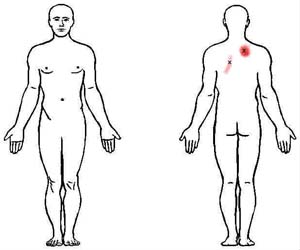
Chiropractor Chandler AZ
Trapezius Trigger Point

The origin of the trapezius muscle is in the spinous processes of vertebrae C1-T12. Its insertion is in the external occipital protuberance, nuchal ligament, medial superior nuchal line, posterior border of the lateral third of the clavicle, acromion process, and spine of scapula. The trapezius muscle is innervated by the accessory nerve (motor), and cervical spinal nerves C3 and C4 (motor and sensation).
The trapezius is a large kite-shaped muscle, covering much of the back and posterior neck and commonly contains trigger points. There are three main parts to the muscle: the upper, middle, and lower trapezius, and each part of the muscle has its own actions. The diagrams below show the location of the trapezius muscle, and the areas that are considered the trigger points are marked with x’s. Referral pain from these trigger points can cause these common symptoms:
Upper Trapezius -
- headaches on the temples / "tension" headaches
- facial, temple, or jaw pain
- pain behind the eye
- dizziness or vertigo (in conjunction with the sternocleidomastoid muscle)
- severe neck pain
- a stiff neck
- limited range-of-motion
- intolerance to weight on your shoulders
Middle Trapezius -
- mid-back pain
- headaches at the base of your skull
- TrP5 refers superficial burning pain close to the spine
- TrP6 refers aching pain to the top of the shoulder near the joint
Lower Trapezius -
- mid-back, neck, and/or upper shoulder region pain
- possibly referral on the back of the shoulder blade, down the inside of the arm, and into the ring and little fingers (TrP7), very similar to a serratus posterior superior referral pattern
- headaches at the base of the skull
- TrP3 can refer a deep ache and diffuse tenderness over the top of the shoulder
Conservative Treatments
Therapeutic treatments for addressing soft tissue injuries involve massage therapy, manual therapy, trigger point therapy, Graston Technique, or Active Release Technique. These treatments increase blood flow, decrease muscle spasms, enhance flexibility, speed healing, and promote proper tissue repair.
When these treatments are incorporated into a treatment plan patients heal faster and are less likely to have long-term pain or soft tissue fibrosis or scar tissue in the injured muscle. These soft tissue treatments are incorporated with therapeutic exercise and flexibility programs. More information can be found on back pain treatments page.
Medical Treatments
NSAIDs are often prescribed for the initial acute injury stages. In severe cases that involve multiple joint regions, muscle relaxers or oral steroids can be given. Trigger point injections, botox, or steroid injections can be treatment options. Pain management is not usually required unless stronger medications or joint injections are required for treatment.
MRI and X-rays will not usually be ordered to evaluate mild to moderate muscle, tendon, and ligament injuries. Severe cases may utilize advanced imaging to rule out bone fractures, edema, nerve entrapments, tendon or muscle ruptures. NCV testing may be utilized in cases that also involve muscle, sensory, or reflex loss.
Your chiropractor, physical therapist, occupational therapist, or physician will evaluate your condition and make a proper diagnosis and treatment recommendations. Ask them any questions you might have about your injury.
Conclusion
The upper extremity works as a comprehensive unit performing many of the repetitive tasks at home, work, and recreational sports. Injuries to one area of the musculature often indicate that additional damage has been incurred by other muscles.
Many therapeutic exercises can help restore proper strength and endurance to the elbow flexor muscles. Isometric exercises are often the initial treatment exercises. Followed by single plane rubber band exercises for elbow flexion, extension, pronation, and supination movements. Dynamic exercises involving stability ball push-ups can be performed on the wall or floor. The more unstable of the surface the more effort and stabilization is required of all the upper extremity muscles.
Push-ups on a stability ball enhances neuromuscular learning throughout the neck, scapula, shoulder, upper arm, and lower our muscles. Additional strength exercises can be found on the arm and shoulder strengthening pages.
Our Chandler Chiropractic & Physical Therapy clinic treats patients with a variety of muscle, tendon, joint, and ligament injuries. The clinic provides treatment for runners, tri-athletes, and weekend warriors in addition to common headache, neck, and back patients traditionally seen in Chiropractic, Physical Therapy, Massage Therapy clinics. We work with all ages and abilities of the residents in Phoenix, Tempe, Gilbert, Mesa, and Chandler AZ.